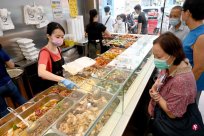Hong Kong's third -quarter local product (GDP) increased by 2.9%year -on -year, the weakest growth rate since the third quarter of 2016, reflecting the beginning of the impact of Sino -US trade friction.
The SAR government said yesterday that considering the actual growth of 3.7%in the first three quarters of this year and the downlink risks of the peripheral environment, the annual economic growth of this year will be predicted to 3.2%, and the forecast range of 3%to 4%of the 4%to 4%announced in August will be predicted.Inside.
The Hong Kong Government also raised its basic inflation rate and overall consumer price inflation rate throughout the year at the same time, and the inflation rate of the overall consumer price was predicted to 2.7%and 2.4%, and the original predictions were 2.5%and 2.2%.The basic inflation rate rose to 2.8%in the third quarter, with an average of 2.5%in the first three quarters.
According to data released by the Hong Kong Statistics Department yesterday, although the growth rate of GDP in Hong Kong in the third quarter was higher than the trend growth rate in eight consecutive quarters, compared with the growth rate of 3.5%in the second quarter, it slowed down.
Among them, in terms of foreign trade, the overall goods exports increased by 5.0%year -on -year in the third quarter, with a significant increase, which is similar to 4.6%in the second quarter.However, the export of foreign goods trade statistics has slowed significantly in September, reflecting the effects of Sino -US trade friction.
The labor market is still tight in the third quarter, and the unemployment rate of seasonal adjustment has remained at 2.8%, the lowest level in 20 years.Although the employment rate rose slightly to 1.2%, it still belongs to a low level.
In addition, the residential property market in Hong Kong was slightly cooled in the third quarter, and the trading volume of residential properties fell 24%to 14,400 in the third quarter from 18,900 in the second quarter.The month has fallen, which offsets the rise in July.
After the seasonal adjustment, comparison, Hong Kong's substantive GDP fell 0.2%after the second quarter of this year, and achieved a 0.1%increase in the third quarter.
Ou Xixiong, an economic consultant of the Hong Kong Government yesterday, said yesterday that the second US $ 200 billion (S $ 275.4 billion) in the United States was fully implemented on September 24, which may not be reflected in the third quarter.He expects that the second list will affect the economic performance of Hong Kong's fourth quarter, especially by the beginning of next year. Hong Kong manufacturers may "catch up" before the tariffs will be added at the end of this year to affect export figures.
Ou Xixiong also pointed out that the current goods involving two lists only account for about 3.5%of the total exports of Hong Kong. Instead, he pays attention to the indirect impact of Sino -US trade friction, including the economic environment atmosphere and financial market fluctuations.The impact caused by quantity is greater.
He said: "If trade friction cannot be cooled, the impact on Hong Kong's export or overall economic performance may become more and more obvious, and internal demand will inevitably face greater pressure. Due to the uncertainty of the peripheral environment and assetsThe fluctuations in the market may gradually increase consumer emotions. "
If trade friction cannot cool down, it may become more and more obvious on Hong Kong's export or overall economic performance, and internal demand will inevitably face greater pressure.
mdash; mdash; Economic Counselor of the Hong Kong Government Ou Xi Xiong


